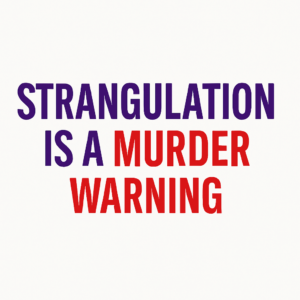
Strangulation Is a Murder Warning —
So Why Are 70% of Cases Still Being Dropped?
By Aneeta Prem MBE JP, Founder of Freedom Charity
Strangulation is a murder warning. It is one of the clearest predictors of future homicide in cases of domestic abuse. It sends a chilling message: I control whether you live or die. And yet, despite the law finally recognising non-fatal strangulation as a serious offence, 70% of cases are still being dropped.
New evidence published in 2025 by Sky News and the Institute for Addressing Strangulation (IFAS) reveals a dangerous truth: survivors are reporting the crime, but the system is still failing to act.
What Makes Strangulation So Serious?
Non-fatal strangulation is far more dangerous than it appears. It may leave no visible injuries, yet cause long-term harm, including stroke, brain damage, PTSD, and death days or weeks later. Victims who have been strangled are seven times more likely to be murdered by their partner (Glass et al., 2008).
These acts often occur in silence, behind closed doors, and disproportionately affect women and girls. Despite this, many survivors are still met with disbelief.
One young woman supported by Freedom Charity said:
“He strangled me until I blacked out. No bruises. The police gave him a caution. That was the end of it.”
This is not rare. This is routine. And it must change.
How the Law Responded — And Why It’s Not Enough
In 2021, Section 75A of the Domestic Abuse Act made non-fatal strangulation a standalone offence. This meant:
-
No visible injury is required
-
The offender can face up to five years in prison
-
Consent is not a defence where serious harm is caused
-
UK nationals can be prosecuted for offences committed abroad
This law was a critical step, but a law is only as strong as its implementation. And the latest data shows we are falling short.
Read the Government factsheet on Section 75A
New 2025 Data: What’s Going Wrong?
According to Sky News, around 70% of non-fatal strangulation cases were dropped in the last year due to evidential issues.
While police are recording more cases under Section 75A, prosecutors are still reluctant to pursue them unless visible injuries are present. This contradicts both the intent of the law and the medical evidence.
“He put his hands around my throat. I thought he was going to kill me.”
– Survivor quoted by Sky News, 2025. Her case was dropped.
This shows what many frontline professionals already know: we are criminalising the act, but not supporting survivors.
Strangulation Is a Murder Warning — But We’re Ignoring It
At Freedom Charity, we repeat this truth without hesitation: strangulation is a murder warning. And unless the system treats it that way, lives will be lost.
To improve outcomes, we urgently need to:
-
Train all police officers and medical staff to recognise symptoms of strangulation
-
Make MRI and CT scans routine in suspected cases — even when there are no bruises
-
Embed strangulation in safeguarding protocols, including schools and health services
-
Prosecute based on clinical evidence, not just physical marks
-
Link survivors to trauma-informed care as a standard, not an exception
This isn’t an optional upgrade — it’s a necessary safeguard.
Why This Offence Must Never Be Treated as “Low-Level”
When a stranger strangles someone in public, we treat it as attempted murder. When it happens behind closed doors, it’s too often labelled as “domestic” — and quietly dropped.
Freedom Charity has long campaigned for survivors’ voices to be heard. Whether it’s strangulation, forced marriage, or dishonour-based abuse — our message is simple: the law must be used, or it becomes meaningless.
Explore our work on dishonour-based abuse and survivor safeguarding
Conclusion: We Changed the Law — Now We Must Use It
The introduction of Section 75A was a historic moment — but it was just the beginning. If police, CPS, and health services are not properly resourced and trained, then survivors will continue to be let down.
If you work in safeguarding, health, education, or justice — please take this seriously. Strangulation is not symbolic. It is fatal.
Strangulation is a murder warning. Let’s start treating it like one.
About the Author
Aneeta Prem MBE JP is the founder of Freedom Charity, author of But It’s Not Fair and Cut Flowers, and a nationally recognised campaigner who helped change the law on forced marriage. She trains professionals across the UK on safeguarding and human rights, with a special focus on protecting women and girls.
References (Yoast-compliant and fully cited)
-
Glass, N. et al. (2008). Non-fatal strangulation is an important risk factor for homicide of women. Journal of Emergency Medicine, 35(3), 329–335.
-
Glass, N. et al. (2005). Strangulation as a marker for future lethal violence in intimate relationships. Journal of Emergency Medicine, 29(3), 329–335.
-
Home Office. (2020). Femicide Census Annual Report.
-
Sky News. (2025). ‘He was going to kill me’: More strangulation cases recorded by police – but many investigations falter. [Online] Available: https://news.sky.com/story/more-strangulation-cases-recorded-but-many-investigations-falter-13144275
-
Domestic Abuse Act 2021, Section 75A. UK Government.
-
Institute for Addressing Strangulation (IFAS), via Sky News (2025)

